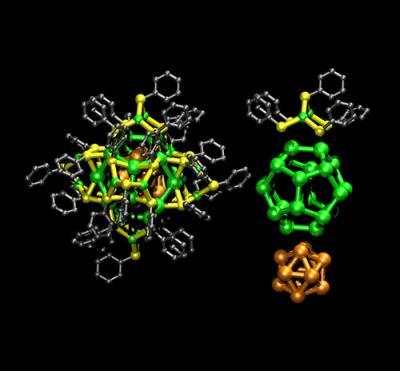Researchers at the Xiamen University in China and the University of Jyväskylä in Finland have characterized a series of stable 1.5 nm metal nanoclusters containing 44 metal atoms, stabilized by 30 organic thiol molecules on the surface. Two types of clusters were synthesized, containing either 44 silver atoms or an intermetallic cluster of 12 gold and 32 silver atoms. The work in the University of Jyväskylä is funded by the Academy of Finland.
The special electronic structure of the clusters leads to peaked absorption of radiation in a wide region of ultraviolet and visible parts of the electromagnetic spectrum. These novel nanomaterials were synthesized first in 2009 by a group at MIT in the USA, but their atomic structure has not been known until now. This is the first case of a very stable silver-based cluster nanomaterial that can be synthesized in a macroscopic scale, currently of the order of 10 grams from one synthesis. This material is expected to be widely studied for optical, sensing and electron-transfer applications in the future. The results were reported online in Nature Communications on 4 September 2013.

Figure: Left: This shows the atomic-scale visualization of the nanoparticle structure with 44 metal sites and 30 thiols. Right: The inner metal core has two shells of 12 and 20 sites (golden and green, respectively), capped by six metal-thiol molecular complexes (one shown on top).
(Photo Credit: Figure : Sami Malola, University of Jyväskylä)
Source: Academy of Finland